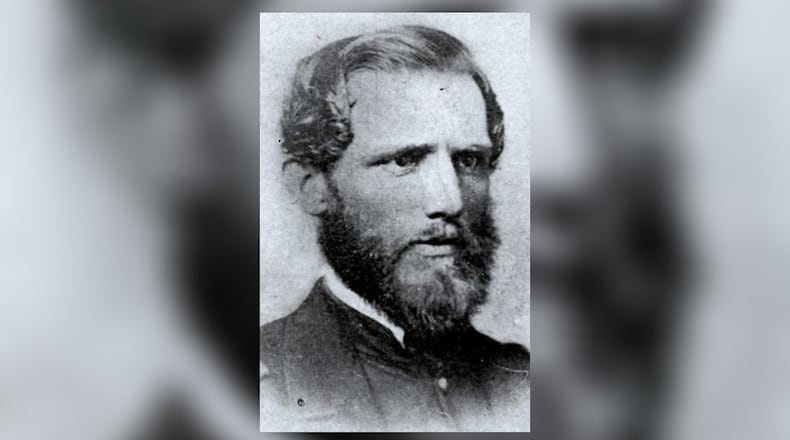Carpentry was the family business, and the Benders had been professionally building structures for at least three generations, and probably more. Bender’s grandfather, Peter Bender, reportedly continued working as a carpenter up until a week before his death at age 85. At the age of 17, Bender left the family farm and began apprenticing in carpentry under his father, eventually becoming highly skilled at the craft.
Bender’s parents immigrated to the United States in 1854, along with all or most of Bender’s thirteen brothers and sisters. They first settled in Cincinnati, before relocating to Hamilton in 1857.
The Benders also had a long tradition of military service, with Bender’s father and grandfather both having served in the Prussian Army. Bender himself was conscripted in 1851 and served a three year term in the Prussian Army before joining his family in Cincinnati in 1855.
While there, Bender met fellow German immigrant Mary Elizabeth (Herdagen) Bender. The couple was married at her family home on Apr. 16, 1857. Soon after, Bender joined his father and brothers in established, F.W. Bender & Sons, a contracting firm located at the northeast corner of Dayton and Lowell streets in Hamilton.
During the American Civil War, Bender was appointed Captain of Company C, 167th Ohio Volunteer Infantry. A “Hundred Days” unit, Bender helped to stand up the unit and was quickly promoted to the rank of major, taking command of the entire regiment.
The 167th OVI was sent to West Virginia in 1864 to serve as rear echelon troops, freeing up veteran combat units to return to the fighting. Maj. Bender was appointed post commander at Gauley Bridge where his unit guarded supply trains until their discharge.
When he returned from the war, Bender, his father and two of his brothers, William and Ernst Bender, started a planing mill operation. When his father died on Oct. 4, 1867, Bender transformed both businesses into a new enterprise, J.F. Bender & Brothers.
What followed was the establishment of a construction empire thus far unknown to the region. J.F. Bender & Brothers grew to be engaged with every aspect of the construction industry, by 1875 advertising itself as, “carpenters, contractors and builders; planing and flooring mill, manufacturers of sash, doors, blinds, mouldings, etc.; also, Lorenz & Bender’s Patent refrigerators and beer coolers.” They sold eight million feet of lumber in 1895.
The company was known for their high quality work and ability to build any type of structure, from residential to industrial to commercial. They earned contracts to build industrial plants for nearly all of the city’s industries, including Niles Tool Works, Mosler Safe & Lock Company, Estate Stove Company, and Shuler & Benninghofen. They also built public buildings, completing three large school buildings by 1894.
As business poured in the company expanded, constructing for themselves a new four-story Second Empire style planing mill and office building around 1883. This structure was later a warehouse for Beckett Paper Company and stood on the site until being destroyed by fire in August 2024.
Under Bender’s leadership, the company adapted to the changing architectural preferences of customers, as can be seen in the variety of Victorian styles represented in surviving examples of their buildings. The Benders also helped start the career of notable local architect George Barkman, who was originally employed by them and who later routinely collaborated with them.
Many of the homes in the Dayton-Campbell Historic District were built by J.F. Bender & Brothers, including the Queen Anne style mansion house at 709 Dayton Street that Bender built for his own family in 1892. A local history states that Mary Bender “presided over” the home, where she and her husband raised their three adopted children, Simon Bender, Barbara (Bender) Erbeck, and Elizabeth “Lizzie” (Bender) Hack.
The firm transitioned once again in 1908, being renamed The Bender Company under the management of William and Ernst Bender. By this time, J.F. Bender also owned and managed the Hamilton Brick Company, a subsidiary, as well as being involved in other business ventures.
Cullen & Vaughn, a newer Hamilton construction firm, took over the operations of the Bender Company Oct. 6, 1913, though the Bender Company continued to exist on paper until around 1930. The company remained in business until closing in 1985 as F.K. Vaughn Building Company.
Bender lived until the age of 90, dying Apr. 7, 1921 at the Bender Mansion. He is buried in Greenwood Cemetery. Mary died on Nov. 11, 1927, at the age of 91, and is buried next to him.
Brad Spurlock is the manager of the Smith Library of Regional History and Cummins Local History Room, Lane Libraries. A certified archivist, Brad has over a decade of experience working with local history, maintaining archival collections and collaborating on community history projects. he may be reached at b.spurlock@lanepl.org.
About the Author

